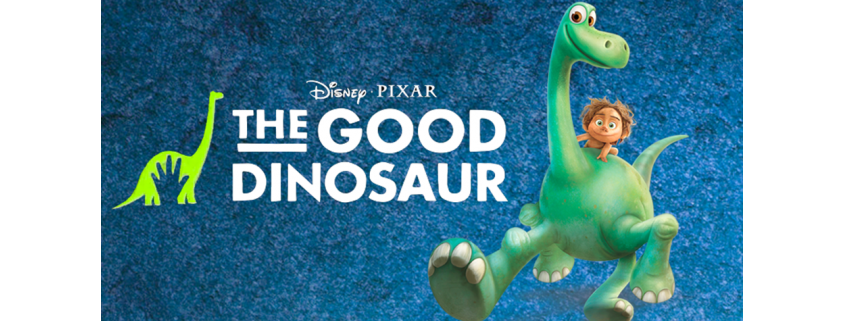Pixar excels again with film The Good Dinosaur
With Pixar’s summer release of Inside Out and the numerous accolades and box office numbers to back up its success, it seemed like the studio’s second original feature of the year, The Good Dinosaur, would have a lot to live up to. Furthermore, the film sparked early criticism when first glimpses showed an oddly cartoonish and wacky looking dinosaur — it seemed more fitting for a baby’s plush doll than the adult-friendly features audience members have come to expect from Pixar. Luckily, The Good Dinosaur surpasses these expectations and more than delivers.
Existing in an alternate reality where the infamous dinosaur-killing meteor never struck earth, The Good Dinosaur is about a young apatosaurus named Arlo who can’t seem to overcome his overwhelming fears. The runt of three siblings in an agrarian household, Arlo is relegated to menial jobs on the family farm, like feeding the chickens and cleaning up leaves. When his father dies after Arlo fails to kill the “critter” that’s eating their harvest, Arlo finds himself lost and far from home. His only company ends up being the very critter Arlo failed to kill: a tiny, non-speaking cavechild who walks on four legs like a canine and is nicknamed Spot. From there, the two begin their journey back to Clawed-Tooth Mountains but are confronted by crazy pterodactyls, vicious velociraptors, a never-ending storm, wrong turns and plenty of more bumps along the way.
Though the story may seem run-of-the-mill — besides the fact that it subverts the classic Disney trope of the mother dying — what truly elevates the film is the shockingly detailed and realistic scenery throughout. More than once, it’s almost impossible to discern whether or not the images flashing on screen are real or animated. Great roaming vistas, sloping valleys, rushing rivers and craggy mountains are painstakingly detailed and extraordinary, leaving the viewer filled with a great sense of wonder and awe long after the film is over.
Yet, simultaneously, the exceedingly cartoonish drawings of Arlo and his family come off as glaring and odd against these photorealistic backdrops, but soon it becomes clear that with all the trials and terrors Arlo faces, having the dinosaurs look too real would probably prove to be too scary for the intended younger audience. Therefore, the caricaturistic features of the animals in the film make it more approachable, while simultaneously astounding audiences with breathtaking landscapes from beginning to end. There are a few more serious issues with the film, however. At first, the human-like sowing and farming dinosaur family set in a sort of prehistoric Midwest seems like a strange choice for Pixar, which should be pushing diversity as much as possible. Arlo’s “Poppa” and “Momma” are voiced by actors with thick Southern accents, characters are named “Buck” and “Butch” and told they “showed real grit today,” and composer-duo Mychael and Jeff Danna underscore the action with twangy, Americana country music that makes the film initially feel like a campy trip back to Little House on the Prairie or something equally as corny and old fashioned. However, by the end it becomes clear that all that Southern charm and influence stems from an overarching metaphor that Arlo is in the wild, wild west. And that’s where the movie really finds its footing — in imagining a West with dinosaurs instead of people, a West where American imperialism isn’t allowed to exist and the humans of the time can’t even speak, let alone ravage a landscape or drive out its native inhabitants. Instead, the dinosaurs appreciate the land and live in somewhat harmony with it as well.
The only true trip-up in the film is the average-to-sub-par dialogue present in the beginning as the filmmakers are building the rules of the world around us. Thankfully, that kind of dialogue all but disappears a quarter of the way in, when the film centers on the unspoken and budding relationship between a dinosaur and his human counterpart and the adventure that unfolds before them.
The problem with this summer’s Inside Out lies in how the stakes didn’t seem to be that big for the protagonists and the adventure they went on really didn’t have that many hurdles. There seemed to be so many options to explore in the human brain — it didn’t really feel like the filmmakers dared to go that far. On the other hand, with The Good Dinosaur, the seemingly insurmountable trials and unending odyssey catapults the film from a good story to a great one. When Arlo finally reaches home — as, of course, we know he ultimately will — the payoff seems deserved and rewarded. He didn’t simply leap over a couple logs and find the river back but rather encounters terrifying obstacles every which way and traverses miles upon miles of the untouched landscape. This not only leaves the viewer with a warm feeling by the film’s end, but also a hankering to go visit some of our national parks and forests, which means the dinosaur really lives up to its name.

